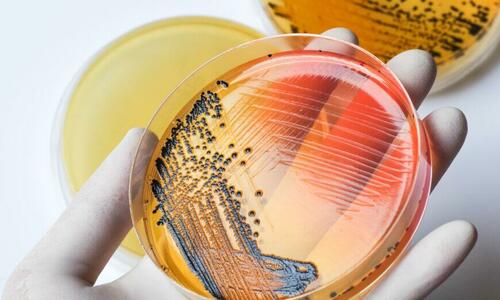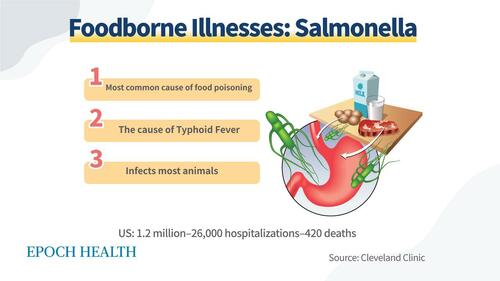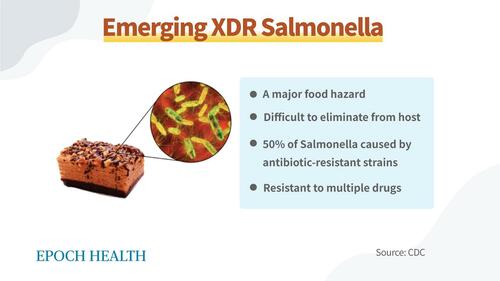
Authored by Dr. Sean Lin and Jacky Guan via The Epoch Times (emphasis ours),
Salmonella is perhaps the most common cause of food poisoning. It has the advantage of being able to infect a wide range of hosts and survive in habitats ranging from animal fur to lettuce leaves. However, a rising trend of drug-resistant Salmonella cases (pdf), as indicated in a review published in the journal Foods, points to the need for improved detection and prevention methods.
Salmonella Essentials
As a key cause of diarrheal diseases and the cause of typhoid fever, Salmonella strains are responsible for causing 1.2 million illnesses annually. First and foremost, the gram-negative bacteria are known for causing stomach pains and diarrhea when a person eats something that has “gone bad.” Salmonella has about 2,500 variants and is responsible for the hospitalization of more than 25,000 people, as well as the deaths of over 400 each year in the United States alone.
Aside from stomach cramps and diarrhea, Salmonella infection can cause fever, nausea, vomiting, and a rather formidable headache. In addition, an infection caused by Salmonella Typhi could lead to typhoid fever. Along with the other aforementioned symptoms, typhoid fever leads to a skin rash and muscle weakness, and a fever as high as 103 to 104 F (39 to 40 C).
Salmonella bacteria are especially difficult to address due to the wide range of hosts and environments in which they can survive. They are nearly ubiquitous as they can live within birds, reptiles, amphibians, and most household pets. Aside from that, they can survive in frozen, fresh, and even processed goods, which is why you hear about Salmonella outbreaks popping up here and there in everything from salami sticks to “raw frozen breaded stuffed chicken products.”
The U.S. Centers for Disease Control and Prevention (CDC) has recorded a long list of Salmonella outbreaks starting from 2006. Usually, symptoms begin to appear six hours to six days after infection and last anywhere from four days to a week. However, people may also experience a lengthy period of symptoms that extends across many weeks, or no symptoms at all.
Salmonella diagnosis is usually performed in a laboratory and requires individual samples of blood, body tissue, or fluids. The diagnosis might take anywhere between one and five days, depending on the samples.
Salmonella treatment is usually supportive rather than targeted because, most of the time, drugs actually don’t help much. Fluid restoration is crucial as diarrhea caused by the disease tends to dehydrate the body. Plenty of rest is also highly recommended.
Antibiotics such as ciprofloxacin, azithromycin, and ceftriaxone are sometimes needed to treat patients with severe Salmonella infections. However, Salmonella infections with drug-resistant strains can be severer and have higher hospitalization rates.
Multidrug-Resistant Salmonella: What Do We Do?
The rise of drug-resistant strains of Salmonella is also part of the reason why Salmonella treatment is usually only supportive. The doctor can prescribe you anti-diarrhea medicine or antibiotics, but you’ll run some risks while taking those drugs. For one, diarrhea medication might prolong the duration of symptoms while the infection runs its course. Antibiotics aren’t usually recommended either, as they may be unnecessary and cause more harm than positive results.
Salmonella usually infect the intestines and usually won’t land in the bloodstream. Antibiotics, on the other hand, are usually for treating diseases that infect the bloodstream, which means that there essentially is no point in taking them in the first place. Additionally, excessive use of antibiotics has led to an increase in drug-resistant Salmonella.
At least 100,000 infections in the United States alone are due to antibiotic-resistant Salmonella, including strains that are resistant to ceftriaxone and ciprofloxacin, according to the Foods review. There have also been Salmonella outbreaks that involved strains resistant to multiple antibiotics, including ampicillin, streptomycin, sulfisoxazole, and tetracycline.
Read more here...
Authored by Dr. Sean Lin and Jacky Guan via The Epoch Times (emphasis ours),
Salmonella is perhaps the most common cause of food poisoning. It has the advantage of being able to infect a wide range of hosts and survive in habitats ranging from animal fur to lettuce leaves. However, a rising trend of drug-resistant Salmonella cases (pdf), as indicated in a review published in the journal Foods, points to the need for improved detection and prevention methods.
Salmonella Essentials
As a key cause of diarrheal diseases and the cause of typhoid fever, Salmonella strains are responsible for causing 1.2 million illnesses annually. First and foremost, the gram-negative bacteria are known for causing stomach pains and diarrhea when a person eats something that has “gone bad.” Salmonella has about 2,500 variants and is responsible for the hospitalization of more than 25,000 people, as well as the deaths of over 400 each year in the United States alone.
Aside from stomach cramps and diarrhea, Salmonella infection can cause fever, nausea, vomiting, and a rather formidable headache. In addition, an infection caused by Salmonella Typhi could lead to typhoid fever. Along with the other aforementioned symptoms, typhoid fever leads to a skin rash and muscle weakness, and a fever as high as 103 to 104 F (39 to 40 C).
Salmonella bacteria are especially difficult to address due to the wide range of hosts and environments in which they can survive. They are nearly ubiquitous as they can live within birds, reptiles, amphibians, and most household pets. Aside from that, they can survive in frozen, fresh, and even processed goods, which is why you hear about Salmonella outbreaks popping up here and there in everything from salami sticks to “raw frozen breaded stuffed chicken products.”
The U.S. Centers for Disease Control and Prevention (CDC) has recorded a long list of Salmonella outbreaks starting from 2006. Usually, symptoms begin to appear six hours to six days after infection and last anywhere from four days to a week. However, people may also experience a lengthy period of symptoms that extends across many weeks, or no symptoms at all.
Salmonella diagnosis is usually performed in a laboratory and requires individual samples of blood, body tissue, or fluids. The diagnosis might take anywhere between one and five days, depending on the samples.
Salmonella treatment is usually supportive rather than targeted because, most of the time, drugs actually don’t help much. Fluid restoration is crucial as diarrhea caused by the disease tends to dehydrate the body. Plenty of rest is also highly recommended.
Antibiotics such as ciprofloxacin, azithromycin, and ceftriaxone are sometimes needed to treat patients with severe Salmonella infections. However, Salmonella infections with drug-resistant strains can be severer and have higher hospitalization rates.
Multidrug-Resistant Salmonella: What Do We Do?
The rise of drug-resistant strains of Salmonella is also part of the reason why Salmonella treatment is usually only supportive. The doctor can prescribe you anti-diarrhea medicine or antibiotics, but you’ll run some risks while taking those drugs. For one, diarrhea medication might prolong the duration of symptoms while the infection runs its course. Antibiotics aren’t usually recommended either, as they may be unnecessary and cause more harm than positive results.
Salmonella usually infect the intestines and usually won’t land in the bloodstream. Antibiotics, on the other hand, are usually for treating diseases that infect the bloodstream, which means that there essentially is no point in taking them in the first place. Additionally, excessive use of antibiotics has led to an increase in drug-resistant Salmonella.
At least 100,000 infections in the United States alone are due to antibiotic-resistant Salmonella, including strains that are resistant to ceftriaxone and ciprofloxacin, according to the Foods review. There have also been Salmonella outbreaks that involved strains resistant to multiple antibiotics, including ampicillin, streptomycin, sulfisoxazole, and tetracycline.
Read more here…
Loading…










